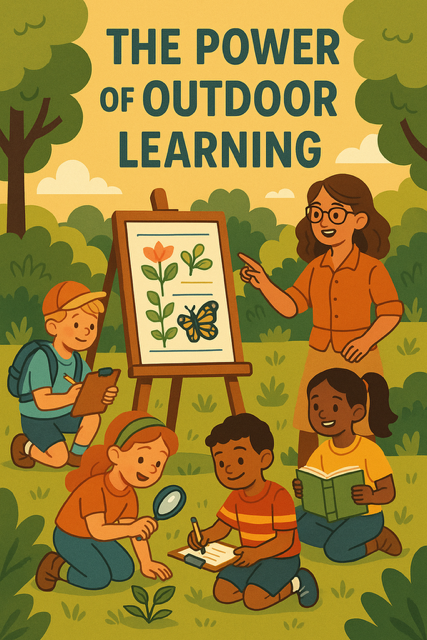
DISCOUNTED EDUCATION PRICING! CALL 1-877-891-8411. We Gladly Accept School Purchase Orders!

Outdoor learning has emerged as a transformative approach to education, blending academic rigor with the enriching experiences of the natural world. As parents, educators, and students increasingly seek innovative ways to enhance learning, terms like outdoor learning, outdoor education, outdoor schools, nature-based learning, and forest schoolshave surged in popularity. This blog explores the benefits, methodologies, and growing movement of outdoor learning, offering insights into why it’s becoming a cornerstone of modern education.
Outdoor learning refers to structured educational activities that take place outside the traditional classroom, often in natural environments like forests, parks, or school gardens. Unlike casual outdoor play, outdoor learning integrates curriculum-based instruction with hands-on, experiential activities. It encompasses a wide range of approaches, including outdoor education programs, forest schools, nature-based education, and experiential learning outdoors. The goal is to foster academic, social, and emotional growth by leveraging the natural world as a dynamic classroom.
Popular search terms like “benefits of outdoor learning“, “outdoor schools near me”, and “nature-based curriculum” reflect a growing public interest in this educational model. Research shows that outdoor learning not only enhances academic performance but also promotes physical health, mental well-being, and environmental awareness.
Studies consistently show that outdoor learning boosts academic outcomes. According to a 2018 study by the American Institutes for Research, students participating in outdoor education programs demonstrated improved test scores in math, reading, and science. The hands-on nature of outdoor learning—whether through conducting science experiments in a forest or solving math problems using natural objects—engages multiple senses, making abstract concepts tangible.
For example, in a forest school, children might measure tree circumferences to practice geometry or observe ecosystems to understand biology. These real-world applications make learning memorable and relevant, addressing the common search query “how does outdoor learning improve education?”
With childhood obesity rates rising and screen time increasing, outdoor learning offers a vital antidote. Activities like hiking, gardening, or building shelters in outdoor classrooms promote physical activity, improving cardiovascular health and motor skills. The National Institute of Health reports that children who spend more time outdoors have lower rates of obesity and stress-related disorders.
Mentally, outdoor learning reduces anxiety and enhances focus. The concept of “nature-based learning” taps into biophilia—the innate human connection to nature—which calms the mind and boosts mood. Searches for “outdoor learning and mental health” highlight this growing awareness, as parents and educators seek holistic approaches to child development.
Outdoor learning fosters collaboration, communication, and resilience. Group activities like team-building exercises or environmental projects encourage students to work together, developing leadership and empathy. Forest schools, for instance, emphasize child-led exploration, allowing students to take risks and solve problems independently, which builds confidence.
The social benefits align with searches for “outdoor learning activities for kids”, as parents look for programs that nurture well-rounded individuals. By engaging with peers in natural settings, children learn to navigate conflicts and build stronger relationships.
As climate change becomes a pressing global issue, outdoor learning instills a sense of environmental responsibility. Programs like outdoor science education teach students about ecosystems, sustainability, and conservation. By interacting directly with nature, students develop a deeper appreciation for the environment, addressing the popular search term “outdoor learning and environmental awareness”.
For example, a school garden project might involve composting, planting, and studying soil health, connecting students to the food cycle. This hands-on approach makes abstract concepts like sustainability concrete and actionable.
The diversity of outdoor learning models caters to various educational needs and settings. Below are the most prominent types, reflecting high-ranking search terms like “types of outdoor schools” and “outdoor education programs”.
Originating in Scandinavia, forest schools are immersive programs where children spend extended periods in natural settings, typically woodlands. These schools prioritize child-led learning, where students explore, build, and play under the guidance of trained educators. Forest schools are particularly popular in early childhood education, with searches for “forest schools near me” spiking as parents seek nature-based alternatives to traditional preschools.
Outdoor classrooms are designated spaces on school grounds or nearby parks where lessons are conducted outdoors. These spaces might include garden beds, seating areas, or weather stations. They’re ideal for schools with limited access to wild spaces, addressing queries like “outdoor learning in urban schools”. Outdoor classrooms integrate subjects like science, art, and literature, making them versatile for all grade levels.
This approach incorporates activities like rock climbing, kayaking, or orienteering to teach problem-solving and resilience. Often used in outdoor education camps, adventure-based programs appeal to older students and align with searches for “outdoor learning for teens“. These programs emphasize physical challenges and teamwork, fostering personal growth.
Designed for young learners, nature-based preschools blend play and learning in outdoor settings. They incorporate storytelling, crafts, and exploration to develop foundational skills. The rise in searches for “nature-based preschools near me” reflects their growing popularity among parents seeking holistic early education.
For educators and schools looking to adopt outdoor learning, the process requires planning and creativity. Here are practical steps to address queries like “how to start an outdoor learning program”:
Despite its benefits, outdoor learning faces challenges, as reflected in searches like “challenges of outdoor education”. Common obstacles include:
The demand for outdoor schools and nature-based education is growing, driven by parental interest and research-backed benefits. As searches for “outdoor learning trends 2025” increase, innovations like virtual reality nature simulations and mobile outdoor classrooms are emerging. These advancements make outdoor learning accessible even in urban or resource-constrained settings.
Moreover, the global push for sustainability is elevating outdoor learning’s role in fostering environmentally conscious citizens. Schools worldwide are adopting green curricula, integrating climate education into outdoor programs. This aligns with searches for “outdoor learning and sustainability”, signaling a shift toward eco-centric education.
For parents searching “outdoor schools near me” or “nature-based learning programs”, here are steps to locate quality options:
Outdoor learning is more than a trend—it’s a revolution in education. By harnessing the power of nature, outdoor schools, forest schools, and outdoor-based learning programs are reshaping how students learn and grow. From boosting academic performance to fostering environmental stewardship, the benefits are undeniable. As searches for “outdoor learning benefits”, “outdoor education programs”, and “forest schools near me” continue to rise, it’s clear that this movement is here to stay.
Whether you’re a parent seeking a nature-based preschool or an educator exploring outdoor learning activities, the opportunities are vast. Embrace the outdoors, and watch learning come alive in ways a traditional classroom never could.